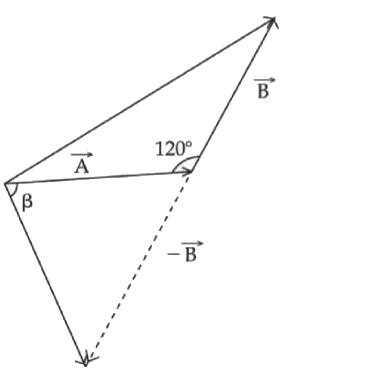If the angle between two vectors →Aand→B is 90∘ then
→A=2→B
→A−→B=→0
∣∣→A+→B∣∣=∣∣→A−→B∣∣
→A+→B=→0
The correct Answer is:C
Step by step video, text & image solution for If the angle between two vectors vecA and vecB " is " 90^(@) then by Physics experts to help you in doubts & scoring excellent marks in Class 12 exams.
Topper's Solved these Questions
- BOOK - AAKASH INSTITUTECHAPTER - MOTION IN A PLANEEXERCISE - Assignement section -B Objective (one option is correct)24videos
MOTION IN A PLANE
- BOOK - AAKASH INSTITUTECHAPTER - MOTION IN A PLANEEXERCISE - Assignement section -C Objective (More than one option is correct)5videos
MOTION IN A PLANE
- BOOK - AAKASH INSTITUTECHAPTER - MOTION IN A PLANEEXERCISE - Try yourself48videos
MOTION IN A PLANE
- BOOK - AAKASH INSTITUTECHAPTER - MOCK_TEST_17EXERCISE - Example15videos
MOCK_TEST_17
- BOOK - AAKASH INSTITUTECHAPTER - MOTION IN A STRAIGHT LINEEXERCISE - ASSIGNMENT (SECTION - D)15videos
MOTION IN A STRAIGHT LINE
Similar Questions
Knowledge Check
- Question 1 - Select One
If the angle between the vectors →aand→b is π3 and the area of the triangle with adjacemnt sides parallel to →aand→b is 3 is
A√3B2sqrt3C4sqrt3D√32 - Question 2 - Select One
If the angle between the vectors →Aand→B is θ, the value of the product (→B×→A)⋅→A is equal to
ABA2cosθBBA2sinθCBA2sinθcosθDZero - Question 3 - Select One
If the angle between the vectors →Aand→B is θ, the value of the product (→B×→A)⋅→A is equal to
ABA2cosθBBA2sinθCBA2sinθcosθDzero
The angle between vector (→A) and (→A−→B) is :
 View Solution
View SolutionFind the angle between two vectors →aand→b with magnitudes 1 and 2 respectively and satisfying →a.→b.=1
View SolutionIf θ is the angle between unit vectors →A and →B, then (1−→A.→B)1+→A.→B⎞⎟ ⎟⎠ is equal to
View SolutionAssertion: The angle between the two vectors (ˆi+ˆj) and (ˆjˆk) is π3 radian.
Reason: Angle between two vectors →A and →B is given by θ=cos−1(→A.→BAB)View SolutionAssertion : The angle between the two vectors
(ˆi+ˆj)and(ˆj+ˆk) is π3 radian.
Reason : Angle between two vectors →Aand→B is given by θ=cos−1(→A⋅→BAB)View Solution

